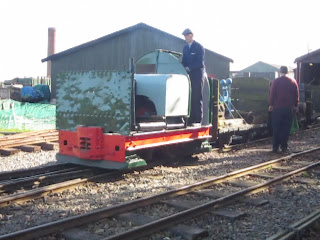 In a nutshell
In a nutshell
Gauge: 15"
Length: approx 1 mile
Opened: 1986
Location:
View Larger Map
Date of visit: 14 October 2012
Key Facts
- The line is situated in Haigh Hall Country Park. Haigh Hall originally belonged for many ages to the Bradshaigh family - the local MP for Wigan before passing to the Earl of Crawford. The Hall and its park are now owned by the Wigan Leisure & Culture Trust.
- The track is in the form of a circuit which is pinched where the tracks pass close to each other
- The track passes mostly through Woodland skirting ornamental lakes and pools.
- There are two stations ‘Haigh Hall South’ which is the main station which also has a three road engine shed and ‘Haigh Hall North’ which is adjacent to the estate's walled garden
- The line has two locomotives - Rachel, a former Fairbourne Railway diesel and Helen, as steam outline 0-6-0 diesel locomotive built by Alan Keef Ltd.
Route
 |
| Source: http://www.wigan.gov.uk/NR/rdonlyres/758EB75A-2814-4FF5-AFAE-7B187314E158/0/HaighHealthWalk1180kb.pdf |
My Impressions
According to the Manchester Countryside website, the railway is supposed to run on Sunday afternoons during the winter months. And so, we set out one October Sunday to explore this railway. The car parks are quite extensive with free parking for disabled badge holders.We parked adjacent to the Stables Tearooms where we indulged in a coffee and an Eccles Cake before seeking out the railway. I realised something was amiss when I found that whereas the children's playgrounds, the Hall, the Tearooms and the walled garden were well signposted, there were no signs indicating the whereabouts or even the existence of the railway. Undaunted, I pressed on and a friendly local inhabitant pointed me in the right direction where I found High Hall North Station, beside the southern edge of the walled garden. The rails were rust-encrusted suggesting they had not been used for some time.
Further inspection confirmed that the trackbed was in need of more than a little TLC.
The trackbed looked well-trodden and so I ventured South, attempting to match my stride to the spacings of the sleepers which in places were the only firm ground amid the mud.After a short, shallow cutting.......
..... the track emerged into a small clearing where it encountered another section of the railway looping off through the trees. Following my original track to the right ..................
........... I soon came across the railway's stock shed, securely padlocked against intrusion (and prying eyes).
The sidings and shed were adjacent to the line's Main Station, Haigh hall South. Where once again neglect of the trackbed was evidence - the grass burying the track in places.
The condition of the sign beside the platform suggested the line had not been used during the previous summer season (and that the price rise had not been sufficient to keep the railway alive).
A further notice attached to a waste bin confirmed the closure of the railway but suggested there might be an alternative available.
I 'continued past the station' on my walk along the trackbed looking in vain for the 'signage board'. The line ran for a short distance on a low embankment beside the main path leading to the hall...
...... before crossing another path and plunging back into the woodland.
The setting for the railway is very picturesque, winding as it does between the trees.
However, it's clear that in places the trackbed needs some attention such as here where there has been some minor subsidence and misalignment.
Although it's not clear from this photo, to the left is a series of ornamental pools and a stream which meanders through the trees beside the railway.
Before long, I once more encountered the other section of track looping out of the trees to my left.
Following the right had track ..........
...... I very soon arrived back at my starting point and explored other features of the park. The hall itself, which has a fine view over the town of Wigan.
The park seems to be popular with dog walkers and with families ............
.... particularly as there is plenty of playground equipment on which the children can burn off their excess energy.
It's disappointing that the railway does not seem to be functioning, particularly given the setting through which it travels. An email from the estate indicates that it will be re-opening during 2013 following some repairs (see comments below)
UPDATE
The railway did indeed re-open in 2013 and is now running at weekends and Bank Holidays between 11.00am and 4.00pm. - see http://www.wigantoday.net/what-s-on/haigh-hall-train-back-in-action-1-5994583

















































